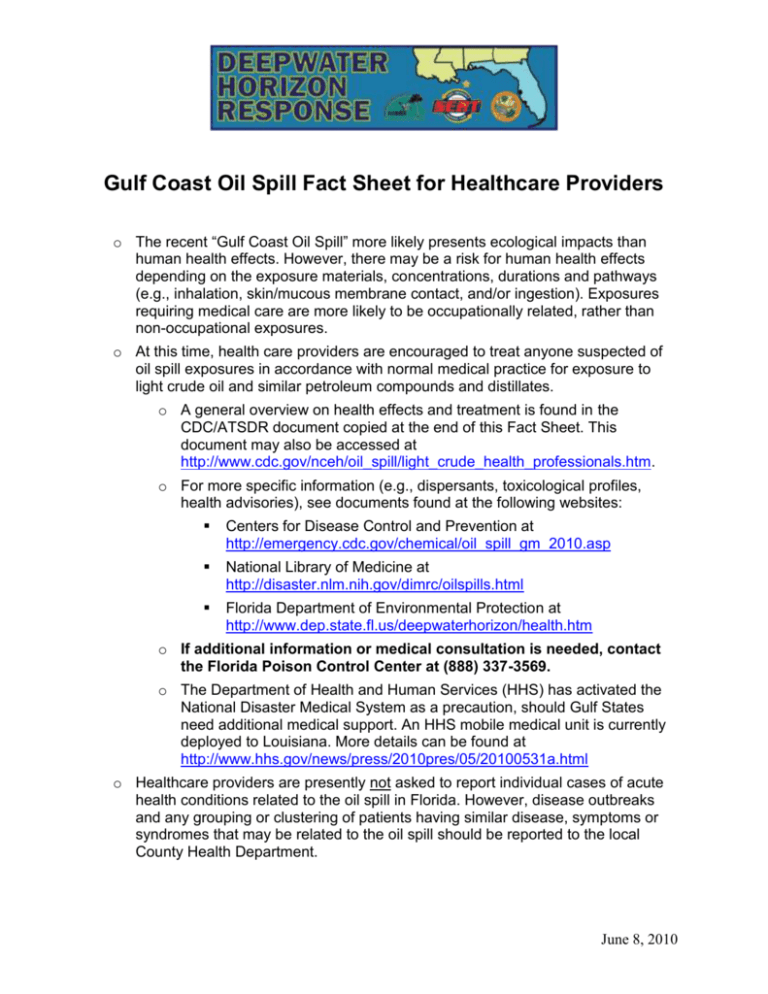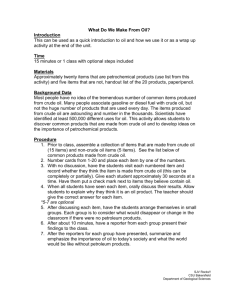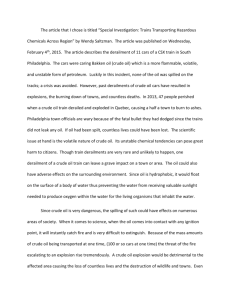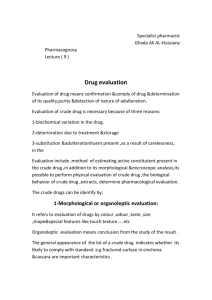Oil Spill Fact Sheet
advertisement

Gulf Coast Oil Spill Fact Sheet for Healthcare Providers o The recent “Gulf Coast Oil Spill” more likely presents ecological impacts than human health effects. However, there may be a risk for human health effects depending on the exposure materials, concentrations, durations and pathways (e.g., inhalation, skin/mucous membrane contact, and/or ingestion). Exposures requiring medical care are more likely to be occupationally related, rather than non-occupational exposures. o At this time, health care providers are encouraged to treat anyone suspected of oil spill exposures in accordance with normal medical practice for exposure to light crude oil and similar petroleum compounds and distillates. o A general overview on health effects and treatment is found in the CDC/ATSDR document copied at the end of this Fact Sheet. This document may also be accessed at http://www.cdc.gov/nceh/oil_spill/light_crude_health_professionals.htm. o For more specific information (e.g., dispersants, toxicological profiles, health advisories), see documents found at the following websites: Centers for Disease Control and Prevention at http://emergency.cdc.gov/chemical/oil_spill_gm_2010.asp National Library of Medicine at http://disaster.nlm.nih.gov/dimrc/oilspills.html Florida Department of Environmental Protection at http://www.dep.state.fl.us/deepwaterhorizon/health.htm o If additional information or medical consultation is needed, contact the Florida Poison Control Center at (888) 337-3569. o The Department of Health and Human Services (HHS) has activated the National Disaster Medical System as a precaution, should Gulf States need additional medical support. An HHS mobile medical unit is currently deployed to Louisiana. More details can be found at http://www.hhs.gov/news/press/2010pres/05/20100531a.html o Healthcare providers are presently not asked to report individual cases of acute health conditions related to the oil spill in Florida. However, disease outbreaks and any grouping or clustering of patients having similar disease, symptoms or syndromes that may be related to the oil spill should be reported to the local County Health Department. June 8, 2010 o CDC recommends using existing mechanisms for surveillance of acute health conditions related to the oil spill. In Florida, these include hospitals/emergency departments participating in the ESSENCE syndromic surveillance system, VA and military treatment facilities participating in the BioSense syndromic surveillance system, and the Florida Poison Information Center Network. o Occupational exposure/injury management and surveillance is a special case. The health and safety of those officially participating in oil clean-up efforts is being managed and monitored by the Deepwater Horizon Unified Command, in close concert with officials from the Occupational Safety and Health Administration (OSHA), the National Institute for Occupational Safety and Health (NIOSH) and the National Institute of Environmental Health Sciences (NIEHS). o Additional background and links to OHSA oil spill clean up safety guides and facts sheets are found in the U.S. Department of Labor news release at http://www.deepwaterhorizonresponse.com/posted/2931/NAT_OSHA_10_ 690_Oil_Spill_Cleanup_Safety_Guides_ENGLISH.556243.pdf. Light Crude Oil Information for Health Professionals Source: Centers for Disease Control and Prevention; Agency for Toxic Substances and Disease Registry (View as PDF [106 KB]) About Light Crude Oil Crude oil is a naturally occurring liquid composed mostly of hydrogen and carbon. It is usually found underground but can also be found above ground in oil seeps or tar pits. [1] Crude oil is called “liquid petroleum” as it comes out of the ground. Light crude oil is a complex mixture containing thousands of different chemicals. Light crude is relatively fluid (low viscosity), will float on water (low specific gravity). Because crude oil has a high proportion of light hydrocarbon fractions, it has a high American Petroleum Institute (API) gravity, which means it is lighter than some other types of oils. When an Oil Spill Occurs Light crude contains volatile organic compounds which evaporate. Thus, light crude oil will lose up to 10 to 15% of its volume immediately, and up to 25% of its volume within 24 hours. How much of its volume is lost depends on the surface-to-volume ratio of the bulk oil. Events that disperse the oil, such as a well blowout, can affect this. Thus, crude oil in a pool or tank will retain more of its volatile components than crude in an oil slick.[2] June 8, 2010 When oil is spilled in the ocean, it initially spreads primarily on the surface of the water. How much it spreads depends on its relative density and composition. The oil slick formed may remain cohesive, or, if seas are rough, it may break up. Waves, water currents, and wind can force the oil slick to drift over large areas, impacting the open ocean, coastal areas, and marine and terrestrial habitats in the path of the drift. Oil that contains volatile organic compounds partially evaporates, losing 20 to 40 percent of its mass and becoming denser and more viscous. A small percentage of oil may dissolve in the water. The oil residue also can spread almost invisibly in the water or combine with water to form a thick mousse-like substance. Part of the oil waste may sink with suspended particulate matter, and the remainder eventually congeals into sticky tar balls. Over time, oil waste deteriorates (weathers) and disintegrates because of exposure to sunlight (photolysis) and biodegradation. The rate of biodegradation depends on the availability of nutrients, oxygen, and microorganisms, as well as temperature. [3] Tar Balls and Health Although not recommended, for most people, an occasional brief contact with a small amount of oil will do no harm. However, some people are especially sensitive to chemicals, including the hydrocarbons found in crude oil and petroleum products. They may have an allergic reaction, or develop dermatitis or a skin rash, even from brief contact with oil. In general, dermal contact with oil should be avoided. If contact occurs, wash the area with soap and water; baby oil; petroleum jelly or a widely used, safe cleaning compound such as the cleaning paste sold at auto parts stores. Avoid using solvents, gasoline, kerosene, diesel fuel, or similar products on the skin. These hydrocarbon-based products, when applied to skin, may present a greater health hazard than the smeared tar ball itself. [3] Prolonged skin contact Prolonged skin contact with crude oil and petroleum products can cause skin erythema (reddening), edema (swelling), and burning. The skin effects can worsen by subsequent exposure to sunlight, because trace contaminants in the oil, such as polycyclic aromatic hydrocarbons (PAHs) are more toxic when exposed to light. Skin contact can result in defatting of the skin, increasing the possibility of dermatitis and secondary skin infections. June 8, 2010 Some persons may be, or may become, sensitive to the crude oil. Depending on the amount and duration of exposure, skin contact with crude oil may be mildly to moderately irritating; in a sensitive individual, the skin effects may be more pronounced after a smaller or shorter exposure. Ingestion Swallowing crude oil, unless in large quantities (e.g., > eight ounces) is unlikely to result in more than transient nausea, possibly vomiting, gastrointestinal tract disturbances, and self-limiting diarrhea. However, vomiting and subsequent aspiration of hydrocarbons such as crude oil may result in significant lung injury. [2] Casualty Care Issues Skin Contamination: Generally, the presence of crude oil on the patient should present no major complications; it can be wiped off whenever convenient in the treatment process. Even so, two warnings should be noted: Oil and oxygen-enriched atmospheres are potentially explosive. Hospital staff whose hands have been contaminated by oil from removing oily clothing from patients can contaminate fittings on equipment which uses oxygen, with potentially disastrous consequences. While oil on the face of a patient does not contraindicate O2 treatment, wipe the oil from the head, neck, and chest of the patient and remove oil-contaminated clothing before placing the O2 mask on the patient. Because an oxygen-enriched atmosphere may exist for up to one foot from a nasal cannula or face mask, sources of ignition should not be used near oil-contaminated persons or clothing. In particular, before using a defibrillator, excess oil should be wiped off of the patient, particularly from the trunk and neck areas. Wound Contamination: Current industrial practice for external and superficial wound cleaning is being modified to include use of waterless hand cleaners, white petrolatum, mineral oil, corn oil, or Neosporin (triple antibiotic) ointment. These agents must be removed as completely as possible from within the wound after efforts to remove the crude oil have been completed. Ocular Exposure: Ocular exposure can result in slight stinging and temporary redness. No permanent damage should result. The immediate treatment is to flush the eye with copious amounts of water for 15 minutes. If the person wears contacts, these should be removed first. Ingestion Exposure: Following ingestion of a small amount of crude oil clinical signs of June 8, 2010 toxicity are generally limited to mild stomach disturbances. The main danger of swallowing crude oil is that can also get into the lungs causing chemical pneumonitis for example if ingested oil is vomited and subsequently aspirated into the lungs. To treat patients exposed via ingestion, do not induce vomiting as this may lead to aspiration of the crude oil into the lung. Inhalation Exposure: Inhalation of fresh crude oil could result in inhalation of associated volatile hydrocarbons. Symptoms including headache, dizziness, confusion, nausea, or vomiting, may occur from breathing vapors given off by crude oil. Inhalation of weathered crude oil is of less concern because of the loss of volatile hydrocarbons. Remove the patient to a clear area and provide supplemental oxygen if needed. References 1. ATSDR, Toxicological Profile for Total Petroleum Hydrocarbons (TPH) DHHS, Editor. 1999: Atlanta, GA. 2. D. A.Macys, R.L.C., J. F. Risher, A. Vinegar, D. E. Dodd, H. G. Wall, RESULTS OF A WORKSHOP ON HEALTH EFFECTS OF CRUDE OIL EXPOSURES RELATED TO OPERATION DESERT STORM, Defense, Editor. 1992, NAVAL MEDICAL RESEARCH INSTITUTE: Bethesda, MD. p. 8-32. 3. NOAA. Tarballs. Responding to Oil Spills 2005 October 15, 2008 Available from: http://response.restoration.noaa.gov/topic_subtopic_entry.php?RECORD_KEY(e ntry_subtopic_topic)=entry_id,subtopic_id,topic_id&entry_id(entry_subtopic_topic )=154&subtopic_id(entry_subtopic_topic)=8&topic_id(entry_subtopic_topic)=1 . *Thank you to the Centers for Disease Control and Prevention (CDC) and Agency for Toxic Substances and Disease Registry (ATSDR) for all information provided in this document. June 8, 2010







